Flask framework study guide to create a simple blog system
I wrote an article about setting up a flask development environment before. Today I will continue with a practical small project - a blog system.
The blog system is very simple, with only one page, and it is small and well-organized. The purpose here is not to do projects for the sake of doing projects. The original intention of this article is to convey the following knowledge points through this exercise:
1. Understand the directory structure of the flask project from a global perspective
2. The operating mechanism of the flask project
3. Flask framework implements MVC architecture
4. flask-sqlalchemy operates mysql database
1. New project: blog system
In pycharm, create a new flask project, as shown below:

The completed directory structure is like this: very simple, a static folder, a templates folder, and a py file

The above directory structure is the initial structure of flask. This can only cope with small projects. For large and complex projects, we need to introduce package management and MVC architecture design.
2. Restructure the directory structure and introduce package management
For the above structure, in the top-level blog3 directory,
1. Create a new runserver.py file as a unified entry file for the project
2. Create a new blog folder, move the existing static, templates, blog3.py to the blog folder, and then create controller and model folders respectively. Rename blog3.py to __init__.py,
The directory now looks like this:
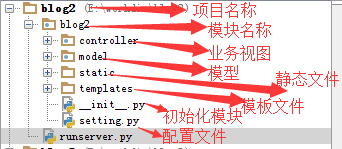
This is equivalent to a large engineering structure:
1) The top-level blog2 directory is the project name. A project can include multiple modules, that is, applications. Each application has its own configuration file, initialization file, and MVC architecture.
2) runserver.py: at the same level as the application module, as the project startup file
3) Second level blog2 directory: module name
Controller directory: C in MVC, mainly stores view functions
Model directory: M in MVC, mainly stores entity class files and maps tables in the database
Templates: V in MVC, stores html files
Static: Static files, mainly storing css, js and other files
__init__.py: Module initialization file, Flask The creation of program objects must be completed in the __init__.py file, and then we can safely import and reference each package.
Setting.py: Configuration file, database username and password, etc.
3. Develop code
1. Run the project first:
1) Write the __init__.py file and create the project object. The code is as follows:
# -*- coding: utf-8 -*- from flask import Flask #创建项目对象 app = Flask(__name__)
2) Add the following code to the runserver.py file:
from blog3 import app
@app.route('/')
def hello_world():
return 'Hello World!'
if __name__ == '__main__':
app.run(debug=True)
3) Run the runserver.py file:

Then enter: http://127.0.0.1:5000/ in the browser, the words helloworld will be displayed

At this point, the prototype of the project can run normally. The next thing is simple. Add content to make the project flesh and blood.
2. Design database
This exercise is relatively simple, with only two tables, one user table and one article table. We use Python's ORM framework flask-sqlalchemy to implement table creation, addition, deletion, modification and query functions.
Add the User.py and Category.py files in the model folder with the following content:
1) User.py:
from blog2 import db
class User(db.Model):
__tablename__ = 'b_user'
id = db.Column(db.Integer,primary_key=True)
username = db.Column(db.String(10),unique=True)
password = db.Column(db.String(16))
def __init__(self,username,password):
self.username = username
self.password = password
def __repr__(self):
return '<User %r>' % self.username
2) Category.py
from blog2 import db
class Category(db.Model):
__tablename__ = 'b_category'
id = db.Column(db.Integer,primary_key=True)
title = db.Column(db.String(20),unique=True)
content = db.Column(db.String(100))
def __init__(self,title,content):
self.title = title
self.content = content
def __repr__(self):
return '<Category %r>' % self.title
3) Create a new setting.py file under the module directory blog2 to configure the database connection information
# _*_ coding: utf-8 _*_ #调试模式是否开启 DEBUG = True SQLALCHEMY_TRACK_MODIFICATIONS = False #session必须要设置key SECRET_KEY='A0Zr98j/3yX R~XHH!jmN]LWX/,?RT' #mysql数据库连接信息,这里改为自己的账号 SQLALCHEMY_DATABASE_URI = "mysql://username:password@ip:port/dbname"
4) Let the project read the configuration file
Modify __init__.py: Add the following content (red part):
# -*- coding: utf-8 -*-
from flask import Flask
from flask_sqlalchemy import SQLAlchemy
app = Flask(__name__)#import os#print os.environ.keys()#print os.environ.get('FLASKR_SETTINGS')#加载配置文件内容app.config.from_object('blog2.setting') #模块下的setting文件名,不用加py后缀 app.config.from_envvar('FLASKR_SETTINGS') #环境变量,指向配置文件setting的路径#创建数据库对象 db = SQLAlchemy(app)
Note: The FLASKR_SETTINGS environment variable needs to be set manually separately. You can enter it in the command line under window:
E:\workdir\blog2> set FLASKR_SETTINGS=E:\workdir\blog2\blog2\setting.py
Or click My Computer-->Advanced-->Environment Variables to create a new one.
5) Create database and tables
In Windows command line mode, cd to the directory of the project runserver.py and enter the python shell:
Enter the red part:
E:\workdir\blog2>python Python 2.7.10 (default, May 23 2015, 09:44:00) [MSC v.1500 64 bit (AMD64)] on wi n32 Type "help", "copyright", "credits" or "license" for more information. >>> from blog2 import db >>> db.create_all() >>> >>>
If there is no error output, it means the database and table were created successfully. At this time we go to the database to check:
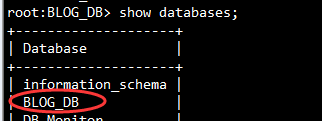
数据库已经存在了,再看看表情况:发现没有对应的b_user和b_category表。这是为什么呢?是不是没有找到model目录下的两个类呢。问题在于:__init__.py文件没有引入model包,导致__init__.py无法找到实体类。记住:一切模块对象的创建都在__init__.py中完成
在blog2目录下的__init__.py添加如下代码:
#只有在app对象之后声明,用于导入model否则无法创建表 from blog2.model import User,Category
再次运行上面命令:db.create_all()方法。这时表已经创建成功了。
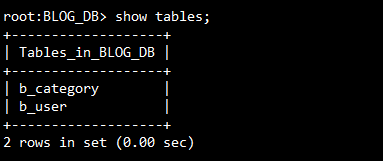
3、添加界面模板:如登陆页面,显示blog文章页面,添加blog页面
在templates目录下添加三个html文件:
layout.html:
<!doctype html>
<title>Flaskr</title>
<link rel=stylesheet type=text/css href="{{ url_for('static', filename='style.css') }}">
<div class=page>
<h1>Flaskr</h1>
<div class=metanav>
{% if not session.logged_in %}
<a href="{{ url_for('login') }}">log in</a>
{% else %}
<a href="{{ url_for('logout') }}">log out</a>
{% endif %}
</div>
{% for message in get_flashed_messages() %}
<div class=flash>{{ message }}</div>
{% endfor %}
{% block body %}{% endblock %}
</div>login.html:
{% extends "layout.html" %}
{% block body %}
<h2>Login</h2>
{% if error %}<p class=error><strong>Error:</strong> {{ error }}{% endif %}
<form action="{{ url_for('login') }}" method=post>
<dl>
<dt>Username:
<dd><input type=text name=username>
<dt>Password:
<dd><input type=password name=password>
<dd><input type=submit value=Login>
</dl>
</form>
{% endblock %}
show_entries.html:
{% extends "layout.html" %}
{% block body %}
{% if session.logged_in %}
<form action="{{ url_for('add_entry') }}" method='POST' class=add-entry>
<dl>
<dt>Title:
<dd><input type=text size=30 name=title>
<dt>Text:
<dd><textarea name=text rows=5 cols=40></textarea>
<dd><input type=submit value=Share>
</dl>
</form>
{% endif %}
<ul class=entries>
{% for entry in entries %}
<li><h2>{{ entry.title }}</h2>{{ entry.content|safe }}
{% else %}
<li><em>Unbelievable. No entries here so far</em>
{% endfor %}
</ul>
{% endblock %}
对应static中添加css文件:style.css
body { font-family: sans-serif; background: #eee; }
a, h1, h2 { color: #377BA8; }
h1, h2 { font-family: 'Georgia', serif; margin: 0; }
h1 { border-bottom: 2px solid #eee; }
h2 { font-size: 1.2em; }
.page { margin: 2em auto; width: 35em; border: 5px solid #ccc;
padding: 0.8em; background: white; }
.entries { list-style: none; margin: 0; padding: 0; }
.entries li { margin: 0.8em 1.2em; }
.entries li h2 { margin-left: -1em; }
.add-entry { font-size: 0.9em; border-bottom: 1px solid #ccc; }
.add-entry dl { font-weight: bold; }
.metanav { text-align: right; font-size: 0.8em; padding: 0.3em;
margin-bottom: 1em; background: #fafafa; }
.flash { background: #CEE5F5; padding: 0.5em;
border: 1px solid #AACBE2; }
.error { background: #F0D6D6; padding: 0.5em; }
4、添加业务逻辑
在controller目录下新建blog_message.py文件:
from blog2.model.User import User
from blog2.model.Category import Category
import os
from blog2 import app,db
from flask import request,render_template,flash,abort,url_for,redirect,session,Flask,g
@app.route('/')
def show_entries():
categorys = Category.query.all()
return render_template('show_entries.html',entries=categorys)
@app.route('/add',methods=['POST'])
def add_entry():
if not session.get('logged_in'):
abort(401)
title = request.form['title']
content = request.form['text']
category = Category(title,content)
db.session.add(category)
db.session.commit()
flash('New entry was successfully posted')
return redirect(url_for('show_entries'))
@app.route('/login',methods=['GET','POST'])
def login():
error = None
if request.method == 'POST':
username = request.form['username']
password = request.form['password']
user = User.query.filter_by(username=request.form['username']).first()
passwd = User.query.filter_by(password=request.form['password']).first()
if user is None:
error = 'Invalid username'
elif passwd is None:
error = 'Invalid password'
else:
session['logged_in'] = True
flash('You were logged in')
return redirect(url_for('show_entries'))
return render_template('login.html', error=error)
@app.route('/logout')
def logout():
session.pop('logged_in', None)
flash('You were logged out')
return redirect(url_for('show_entries'))千万不要忘了在模块级目录下(blog2目录)的__init__.py文件引入视图模块,代码如下:
#只有在app对象之后声明,用于导入view模块 from blog2.controller import blog_manage
5、运行项目,效果如下:
1)输入http://127.0.0.1:5000/,正常情况下你的应该是空白的,因为还没有任何数据。
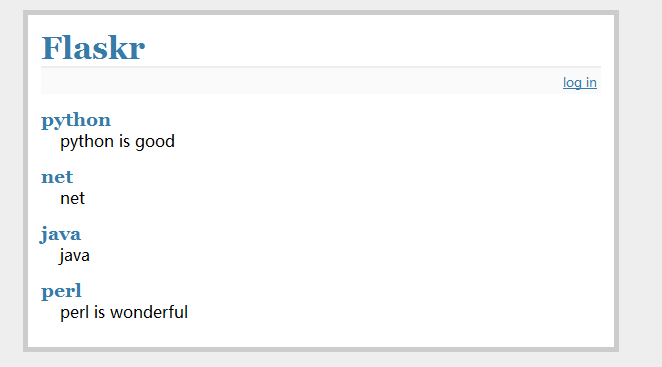
2)点击log in
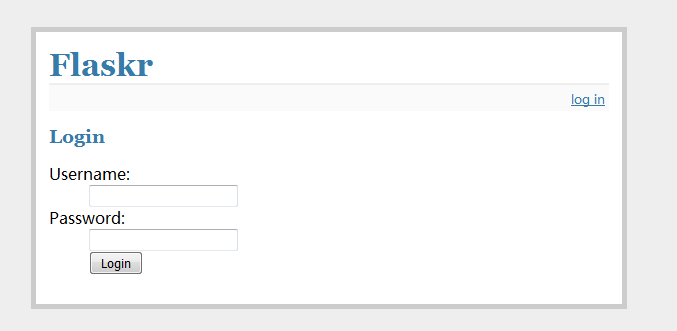
忘了告诉你了,你要事先在b_user表中添加一个用户喔,因为登陆要验证用户的,否则你是无法登陆成功的。
3) 添加条目
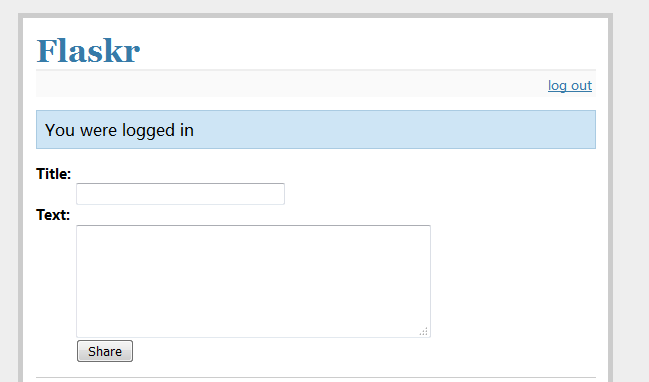
以上就是这个小项目的所有页面,很简单吧。你一定能搞定!!!
【总结】:通过本次练习,是否对flask框架运行机制有所了解呢,是不是已经有了全局的认识了,如果ok,那么这个小练习就有存在价值了。
参考文献:
【flask快速入门中文版】http://docs.jinkan.org/docs/flask/
【flask快速入门英文版】http://flask.pocoo.org/docs/0.11/
【flask-sqlalchemy中文版】http://www.pythondoc.com/flask-sqlalchemy/index.html
【flask-sqlalchemy英文版】http://flask-sqlalchemy.pocoo.org/2.1/

Hot AI Tools

Undresser.AI Undress
AI-powered app for creating realistic nude photos

AI Clothes Remover
Online AI tool for removing clothes from photos.

Undress AI Tool
Undress images for free

Clothoff.io
AI clothes remover

Video Face Swap
Swap faces in any video effortlessly with our completely free AI face swap tool!

Hot Article

Hot Tools

Notepad++7.3.1
Easy-to-use and free code editor

SublimeText3 Chinese version
Chinese version, very easy to use

Zend Studio 13.0.1
Powerful PHP integrated development environment

Dreamweaver CS6
Visual web development tools

SublimeText3 Mac version
God-level code editing software (SublimeText3)

Hot Topics
 1670
1670
 14
14
 1428
1428
 52
52
 1329
1329
 25
25
 1274
1274
 29
29
 1256
1256
 24
24
 PHP and Python: Different Paradigms Explained
Apr 18, 2025 am 12:26 AM
PHP and Python: Different Paradigms Explained
Apr 18, 2025 am 12:26 AM
PHP is mainly procedural programming, but also supports object-oriented programming (OOP); Python supports a variety of paradigms, including OOP, functional and procedural programming. PHP is suitable for web development, and Python is suitable for a variety of applications such as data analysis and machine learning.
 Choosing Between PHP and Python: A Guide
Apr 18, 2025 am 12:24 AM
Choosing Between PHP and Python: A Guide
Apr 18, 2025 am 12:24 AM
PHP is suitable for web development and rapid prototyping, and Python is suitable for data science and machine learning. 1.PHP is used for dynamic web development, with simple syntax and suitable for rapid development. 2. Python has concise syntax, is suitable for multiple fields, and has a strong library ecosystem.
 How to run sublime code python
Apr 16, 2025 am 08:48 AM
How to run sublime code python
Apr 16, 2025 am 08:48 AM
To run Python code in Sublime Text, you need to install the Python plug-in first, then create a .py file and write the code, and finally press Ctrl B to run the code, and the output will be displayed in the console.
 PHP and Python: A Deep Dive into Their History
Apr 18, 2025 am 12:25 AM
PHP and Python: A Deep Dive into Their History
Apr 18, 2025 am 12:25 AM
PHP originated in 1994 and was developed by RasmusLerdorf. It was originally used to track website visitors and gradually evolved into a server-side scripting language and was widely used in web development. Python was developed by Guidovan Rossum in the late 1980s and was first released in 1991. It emphasizes code readability and simplicity, and is suitable for scientific computing, data analysis and other fields.
 Python vs. JavaScript: The Learning Curve and Ease of Use
Apr 16, 2025 am 12:12 AM
Python vs. JavaScript: The Learning Curve and Ease of Use
Apr 16, 2025 am 12:12 AM
Python is more suitable for beginners, with a smooth learning curve and concise syntax; JavaScript is suitable for front-end development, with a steep learning curve and flexible syntax. 1. Python syntax is intuitive and suitable for data science and back-end development. 2. JavaScript is flexible and widely used in front-end and server-side programming.
 Golang vs. Python: Performance and Scalability
Apr 19, 2025 am 12:18 AM
Golang vs. Python: Performance and Scalability
Apr 19, 2025 am 12:18 AM
Golang is better than Python in terms of performance and scalability. 1) Golang's compilation-type characteristics and efficient concurrency model make it perform well in high concurrency scenarios. 2) Python, as an interpreted language, executes slowly, but can optimize performance through tools such as Cython.
 Where to write code in vscode
Apr 15, 2025 pm 09:54 PM
Where to write code in vscode
Apr 15, 2025 pm 09:54 PM
Writing code in Visual Studio Code (VSCode) is simple and easy to use. Just install VSCode, create a project, select a language, create a file, write code, save and run it. The advantages of VSCode include cross-platform, free and open source, powerful features, rich extensions, and lightweight and fast.
 How to run python with notepad
Apr 16, 2025 pm 07:33 PM
How to run python with notepad
Apr 16, 2025 pm 07:33 PM
Running Python code in Notepad requires the Python executable and NppExec plug-in to be installed. After installing Python and adding PATH to it, configure the command "python" and the parameter "{CURRENT_DIRECTORY}{FILE_NAME}" in the NppExec plug-in to run Python code in Notepad through the shortcut key "F6".




